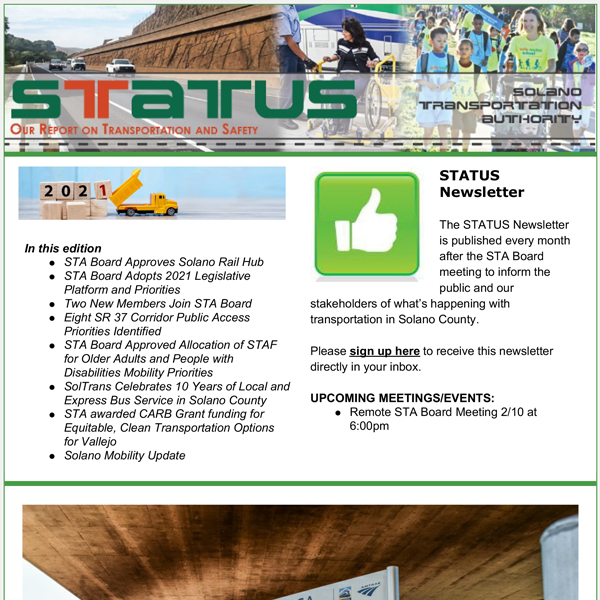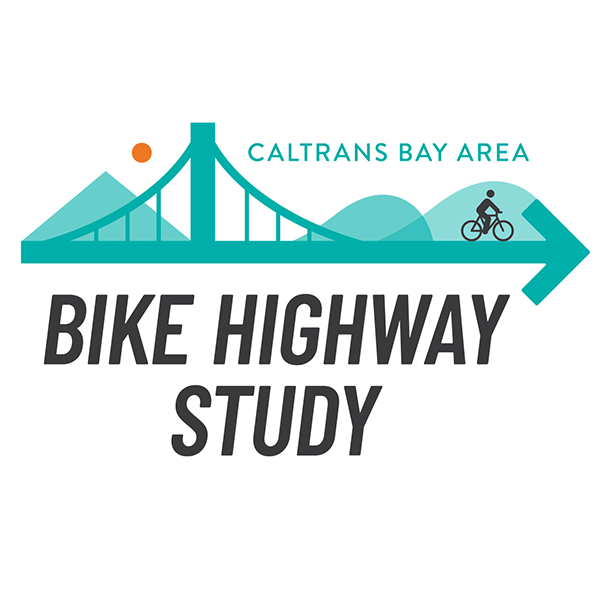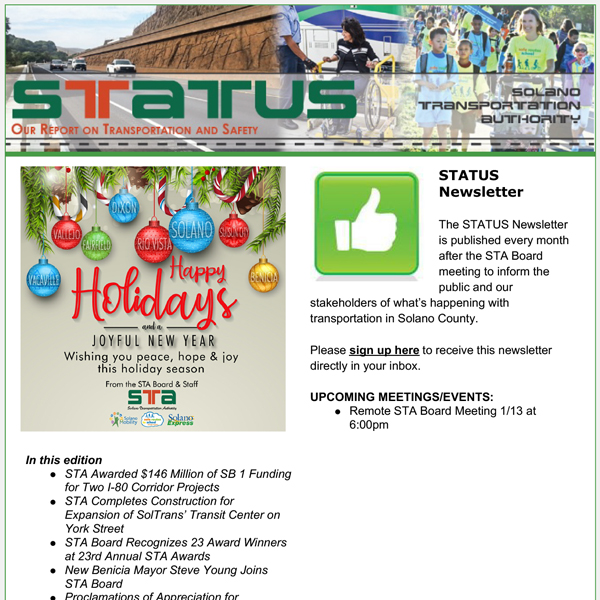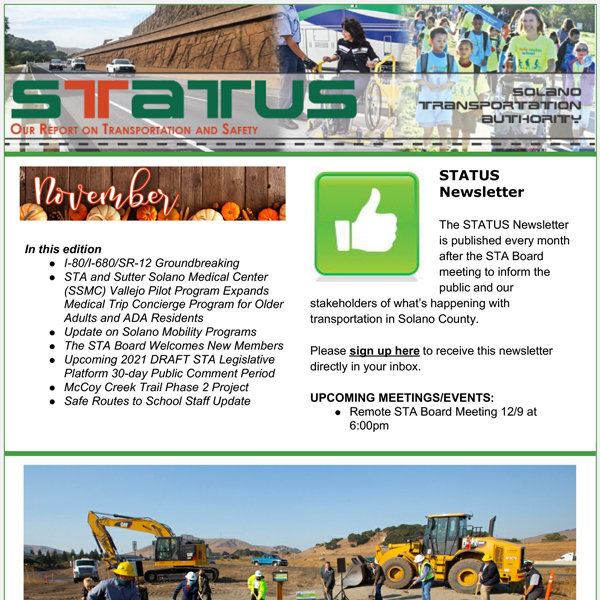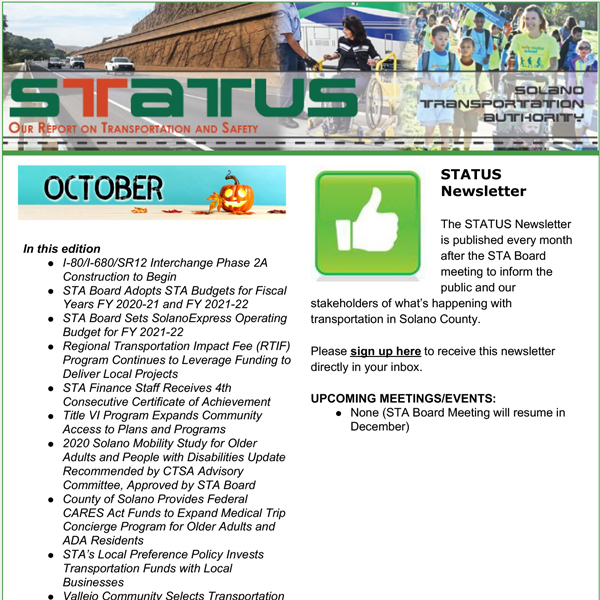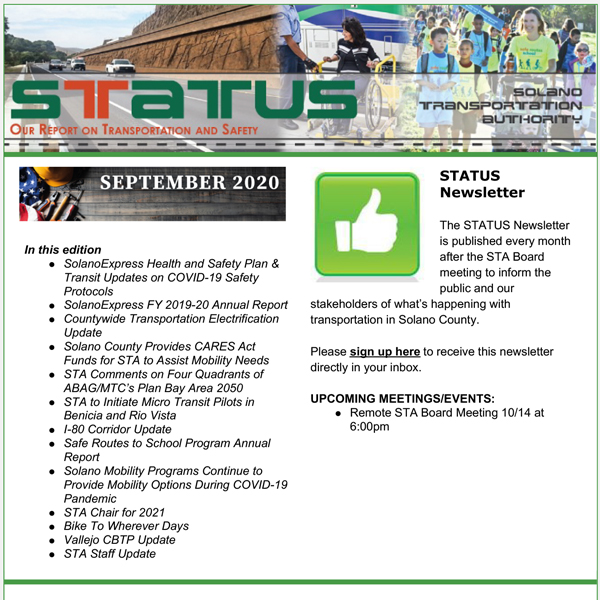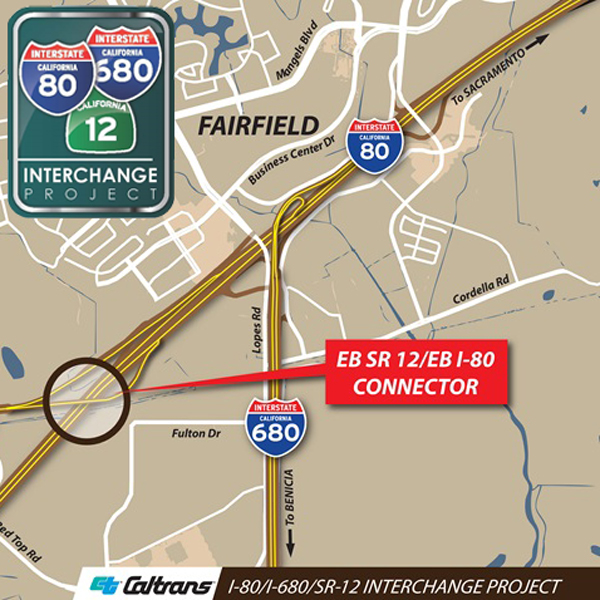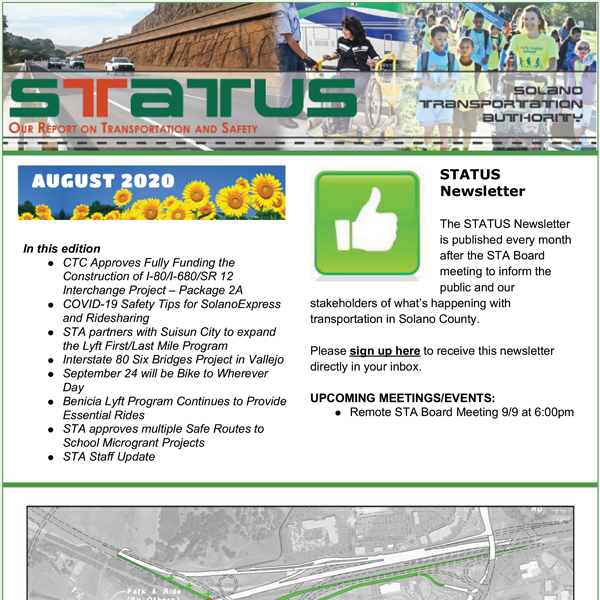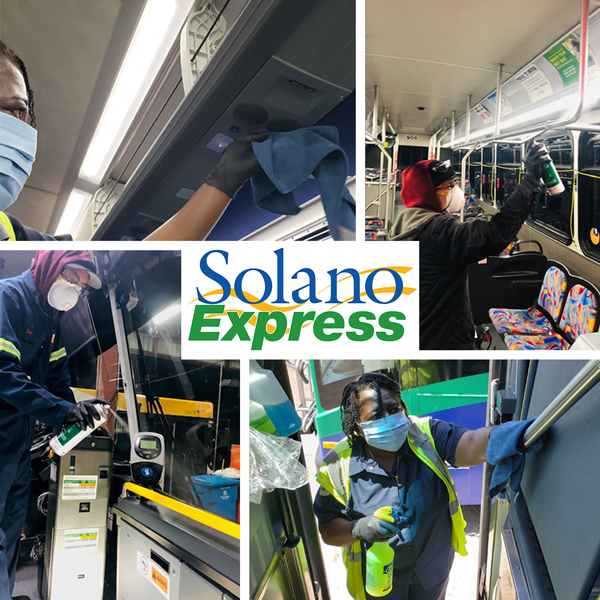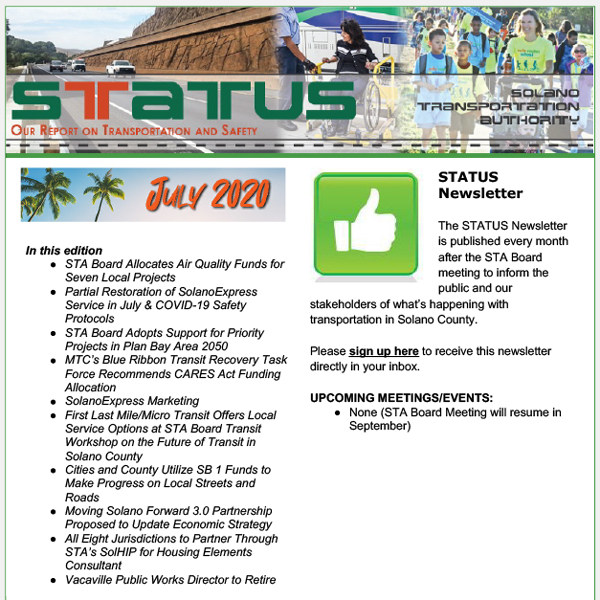The STATUS Newsletter is published every month after the STA Board meeting to inform the public and our stakeholders of what’s happening with transportation in Solano County. Click HERE to view the January STATUS Newsletter 2021.
Bike Highway Study Website & Survey Launch
Caltrans Bay Area is evaluating the implementation of bike highways in the Bay Area and is looking for input from Bay Area bicyclists through their newly launched Bike Highway Study website. The Study website is a resource for collecting input, upcoming events, and bike highway-related websites and resources. Caltrans Bay Area (District 4) manages nearly 1,400 miles of State Highway corridors throughout the Bay Area. The purpose of this Study is to understand where Bike Highways may be installed alongside State Highway corridors.
The Caltrans Bay Area Bike Highway Study Survey seeks to gather feedback on your bicycling habits, which features will make bike highways safe and easy for you to use, and what makes you feel comfortable while bicycling.
What is a Bike Highway?
A bike highway is a high-quality, uninterrupted, long-distance bikeway created to reduce barriers to destinations that people want to travel to and from, especially places which may normally be difficult to bike to. These types of bikeways may consist of a mix of on-street facilities and fully-separated trails. Bike highways should be designed to accommodate people of all ages and abilities riding bikes, as well as people walking and rolling where appropriate and feasible. For this Study, Caltrans is evaluating bike highways parallel to State highway corridors.
The survey will be open through the end of February, and all questions are optional. To take the short survey, click here.
December STATUS 2020
The STATUS Newsletter is published every month after the STA Board meeting to inform the public and our stakeholders of what’s happening with transportation in Solano County. Click HERE to view the December STATUS Newsletter 2020.
November STATUS 2020
The STATUS Newsletter is published every month after the STA Board meeting to inform the public and our stakeholders of what’s happening with transportation in Solano County. Click HERE to view the November STATUS Newsletter 2020.
October STATUS 2020
The STATUS Newsletter is published every month after the STA Board meeting to inform the public and our stakeholders of what’s happening with transportation in Solano County. Click HERE to view the October STATUS Newsletter 2020.
September STATUS 2020
The STATUS Newsletter is published every month after the STA Board meeting to inform the public and our stakeholders of what’s happening with transportation in Solano County. Click HERE to view the September STATUS Newsletter 2020.
I-80/I-680/SR 12 Interchange Package 2A
Caltrans Bay Area will begin work on Interstate 80(I-80), Interstate 680 (I-680) and State Route 12 (SR-12) Interchange Project Package (PKG) 2A in Solano County. I-80/ I-680/SR-12 PKG 2A will focus on relieving congestion by replacing the existing single-lane eastbound (EB) SR-12 to EB I-80 connector with a new two-lane connector and bridge structure which has been designed to accommodate future project phases. The current weave of traffic merging onto EB I-80 from SR-12 and exiting off from EB I-80 to Green Valley Road and SB I-680 will be eliminated by this project. To eliminate this weave, this project will construct a new dedicated off-ramp from EB SR-12 to Green Valley Road and a new braided off-ramp from EB I-80 to Green Valley Road and southbound I-680.
The I-80/I-680/SR-12 is a multi-year, multi-phase project which includes Package 1 through Package 7. The project site will be near Fairfield’s Green Valley and Cordelia neighborhoods. I-80/I-680/SR-12 Interchange PKG 1 was completed in 2017 with a new Green Valley Road Interchange and westbound SR-12 connector from WB I-80 to WB SR-12. I-80/I-680/SR 12 Interchange Package 2A is the second of seven packages improving the distribution of three major freeway movements at this interchange by reconfiguring the ramps and access to local streets. The project is majority-funded with Senate Bill 1 (SB1) Trade Corridor Enhancement Program (TCEP) funds. It is also funded with State Transportation Improvement Program-Regional Improvement Program(STIP-RIP) funds as well as local Bay Area Toll Authority (BATA) Bridge Toll Funds. The project will benefit motorists and the local community by improving travel times, reducing cut-through traffic on local streets, and enhance safety and operational efficiency for motorists along the I-80/I-680/SR-12 Interchange linking the Bay Area, the Napa Valley, and Sacramento. Construction is expected to begin in late September 2020. Package 2A of this project is expected to be completed by Fall 2022.
On Wednesday, September 23, 2020, Caltrans Bay Area, Solano Transportation Authority (STA) and the City of Fairfield held a virtual public informational meeting where Caltrans presented an overview of the I-80/I-680/SR-12 Interchange PKG 2A project to the Solano County community, covering project information and detours that will be in place while the project is underway.
For more information and updates on the I-80/I-680/SR-12 Interchange PKG 2A project, please visit the website at 80-680-12interchange.com .
August STATUS 2020
The STATUS Newsletter is published every month after the STA Board meeting to inform the public and our stakeholders of what’s happening with transportation in Solano County. Click HERE to view the August STATUS Newsletter 2020.
SolanoExpress Health and Safety Plan & Transit Updates on COVID 19 Safety Protocols
As part of the Metropolitan Transportation Commission’s (MTC’s) Blue Ribbon Transit Recovery Task Force recent efforts, MTC recently released a health and safety plan collectively developed by the region’s public transit operators. This Plan provides the drivers and riders with a consistent health and safety plan for the region’s 25 plus transit operators, including the five transit operators that provide service in Solano County, to strengthen trust in riding public transportation (Solano County Transit/SolTrans, Fairfield and Suisun Transit/FAST, Vacaville City Coach, Dixon Readi-Ride, Rio Vista Delta Breeze). These commitments are also based on information from the California Department of Public Health, U.S. Centers for Disease Control and Prevention, and the World Health Organization. The implementation of mitigation steps is based on best practices from peer agencies across the globe. MTC has requested that all of the region’s transit operators adopt “The Riding Together, Health and Safety Plan.”
Listed below are eight safety measures that have been layered together to reduce the likelihood that an individual would contract COVID-19 while riding on SolanoExpress:
- Face Coverings
The Centers for Disease Control and Prevention (CDC) is advising the use of simple cloth face coverings to slow the spread of COVID-19 and help people who may have the virus and do not know it from transmitting it to others (CDC 2020a). With this in mind, face covering became mandatory for all SolanoExpress riders starting June 15, 2020. - Physical Distancing
COVID-19 is thought to spread mainly from person-to-person, between people who are in close contact with each other and through respiratory droplets produced when an infected person coughs, sneezes or talks (CDC 2020b). To promote physical distancing, SolanoExpress buses will allow no more than 20 to 24 riders per bus. - Hand Hygiene
Good hand hygiene can help slow the spread of COVID-19. This includes washing hands with soap and water for at least 20 seconds or using an alcohol-based hand sanitizer containing at least 60 percent alcohol (CDC 2020a). Hand sanitizer is available for both bus operators and riders. - A Quiet Ride Campaign
Droplets expelled through talking, singing, and other verbal activities are known to contribute to virus dispersion (CNN 2020; NEJM 2020). SolanoExpress operators will temporarily adopt the “Quiet Ride” communication campaign, requesting passengers minimize talking, singing or other verbal activities while riding public transportation to slow the spread of COVID-19. Necessary verbal activities, such as requesting a stop, are not precluded. - Vehicle and Facility Conditions-Ventilation
Increased air flow can provide for a healthier environment for transit customers and employees (CDC 2020e; APTA 2020a). SolanoExpress doors are frequently opened to allow passengers to board or exit as well as windows that open, allowing additional ventilation. Where feasible, public transportation providers will increase ventilation and air filtration on vehicles and in facilities. - Touchless Fares
Reducing cash fare payments reduces touch and disease transmittal potential and can reduce the need for face-to-face transactions. SolanoExpress operators are promoting touchless fare payment through Token Transit and Clipper. - Personal Protective Equipment (PPE)
Employees will wear the combination of PPE defined for their job requirements to safeguard themselves and others while in the work environment. STA and SolanoExpress bus operators have been issued PPE which they’re required to use while working. Moreover, driver barriers are being explored and will be installed when the materials are available. - Infected Employees/contract tracing
SolanoExpress contractors will track employees that access transit facilities or equipment, as feasible. If an employee reports an infection, or possible contact with an infected person, SolanoExpress contractors will document and maintain records of what other employees may have come into contact with the exposed or infected employee and notify other employees. SolanoExpress contractors will report any confirmed infections to the Solano County Public Health Department.
The STA Board unanimously approved the Plan for Solano Express service at their September 9th Board meeting. The adherence to the above eight safety measures will be reported out monthly to MTC for SolanoExpress, along with all bay area transit operators, demonstrating alignment with the baseline health measures set forth in the Riding Together: Bay Area Healthy Transit Plan. Read the full plan at http://www.healthytransitplan.org/
July STATUS 2020
The STATUS Newsletter is published every month after the STA Board meeting to inform the public and our stakeholders of what’s happening with transportation in Solano County. Click HERE to view the July STATUS Newsletter 2020.

